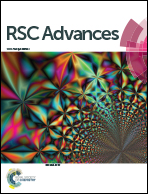Synthesis of piperazine tethered 4-aminoquinoline-pyrimidine hybrids as potent antimalarial agents†
Abstract
A series of 4-aminoquinoline-pyrimidine hybrids linked through piperazine were synthesized and evaluated for their in vitro antimalarial activity against chloroquine (CQ)-sensitive and chloroquine (CQ)-resistant strains of Plasmodium falciparum and cytotoxicity against mammalian cell line (Vero). Nine compounds (5e, 5f, 5g, 5h, 5i, 5j, 5k, 7a, 7d) displayed good antimalarial activity against both the strains out of which compound 5j was the most potent with IC50 values in the range of 0.13–0.14 μM. The antimalarial activity of 5j was 2.5 fold stronger than chloroquine in the CQ-resistant strain of P. falciparum. None of the compounds were found to be cytotoxic against Vero cells. The X-ray crystal structure of one of the compounds was also determined.


 Please wait while we load your content...
Please wait while we load your content...